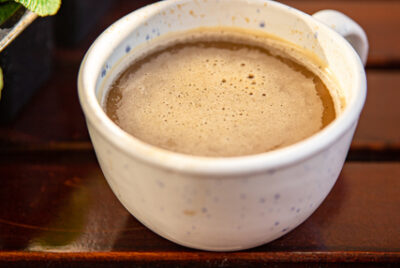How to Make Cuban Coffee: A Coffee Lovers Guide
Have you ever taken a sip of coffee and felt transported to another world? Well, let me share my secret to one such magical brew: Cuban coffee. Rich, sweet, and deeply rooted in tradition, Cuban coffee isn’t just a drink—it’s an experience.
Today, we’ll take a dive into everything needed to make a delicious cup, along with a step by step guide.
Introduction to the World of Cuban Coffee
In the mosaic of global coffee culture, Cuban coffee holds a unique, vibrant tile. But how did this small island nation come to craft such a distinctive and adored brew? Journey with me as we turn back the pages of history.
A Brief History
Cuban coffee, also known as “Cafecito,” has its roots in the beautiful Caribbean Island of Cuba. It arrived there in the mid-1700s and quickly became an integral part of Cuban culture.
Why Cuban Coffee is Unique
Beyond the rich taste, what makes Cuban coffee stand out is its preparation. The unique method of blending sugar with the coffee as it brews creates a special frothy top layer known as ‘espuma’.
Ingredients Needed for the Perfect Cup
When it comes to Cuban coffee, while the list might seem simple, each component plays a crucial role in achieving that distinctive taste and texture. Let’s unpack each one.
1. Freshly Roasted Espresso Beans:
The soul of Cuban coffee lies in the beans. The richer the quality, the better the flavor. Choose a good quality, freshly roasted espresso bean. While traditional Cuban beans are optimal, any dark roast will get you close to the authentic taste.
2. Sugar:
White granulated sugar is the secret to creating the frothy top layer, or “espuma”, which is the signature of a great Cuban coffee. This isn’t just any ordinary foam; it’s a sweet layer that melds seamlessly with the strong coffee beneath.
3. Water:
It might seem like a given, but water can make or break your coffee. Always opt for filtered water if possible. Tap water with impurities or heavy mineral content can interfere with the extraction process and flavor.
Salt (Optional):
A pinch of salt can enhance the flavors. This isn’t traditional, but some swear by this addition. It can neutralize any bitterness and elevate the sweetness.
Optional Add-ins:
While not traditional, if you’re looking to experiment, consider a tiny dash of vanilla extract or a sprinkle of cinnamon. These additions can complement the robust nature of the coffee and add a unique twist to the classic preparation.
Collecting quality ingredients is just the first step. Combining them effectively is where the magic truly happens. Like a symphony, each element, when played correctly, comes together to create a harmonious and flavorful experience. Let’s move forward and see how these ingredients come to life in a Cuban coffee.
Essential Equipment
Ah, the art of making Cuban coffee! It’s more than just a brewing process; it’s a ritual. And like any good ritual, it requires the right tools.
Let me guide you through the essential equipment you’d need to recreate that authentic Cuban coffee experience right in your kitchen.
1. The Moka Pot (Cafetera)
The Heart of Cuban Coffee Making
The Moka Pot, often referred to as a “Cafetera” in Cuban households, is a stovetop coffee maker that is central to brewing Cuban coffee. Its unique design, with a bottom chamber for water, a middle for coffee grounds, and an upper chamber where the brewed coffee emerges, ensures a strong and aromatic brew.
2. Coffee Grinder
Freshness Matters
If you’re buying whole beans – and I’d recommend you do for the freshest flavor – you’ll need a grinder. A burr grinder is preferred, as it offers a consistent grind ensuring optimal extraction of flavors.
3. A Mixing Spoon
The Tool for the Perfect Espumita
A small, deep spoon is essential to whip up the sugar with a bit of coffee to create the characteristic creamy froth on top of a Cuban coffee.
4. Traditional Cups
Serve in Style
While you can serve Cuban coffee in any espresso cup, traditional, small, and often decorative cups enhance the experience. After all, a huge part of enjoying food and drink is the visual appeal.
5. Heat Source
The Fire Beneath
While most people use a stovetop to brew their coffee in a Moka Pot, it’s adaptable to most heat sources. If you’re feeling adventurous, some old-timers in Cuba even use an open flame for an added smoky flavor.
Optional: Electric Milk Frother
For those who love a modern touch
If you’re someone who loves the blend of tradition with a touch of modernity, an electric milk frother can also be used to whip up the sugar and coffee mix for the espumita. It ensures a consistent, velvety froth every time.
Step by Step Guide How to Make Cuban Coffee
Delve into the heart of Cuban culture, one cup at a time. Cuban coffee, with its unique flavor profile and delightful froth (espumita), has the power to transport you to the vibrant streets of Havana. Eager to embark on this flavorful journey? Follow my step-by-step guide to brewing the perfect cup of Cuban coffee:
1. Selecting Your Coffee Beans:
Start Right:
Opt for dark roasted espresso beans. If available, go for authentic Cuban coffee beans. They offer a bold flavor profile that’s quintessential to Cuban coffee.
2. Freshly Grind the Beans:
For the Aromatic Magic:
Aim for a fine consistency, almost like powdered sugar. The fresher the grind, the more aromatic and flavorful your brew will be.
3. Preparing the Moka Pot (Cafetera):
The Brewing Vessel:
-
- Fill the bottom chamber with cold water up to the safety valve.
- Place the freshly ground coffee into the filter basket. Don’t press it down; let it sit loosely.
- Assemble the Moka pot by placing the filter basket into the bottom chamber and screwing on the top part.
4. Brewing Begins:
Watch the Magic Happen:
Place the Moka Pot on the stove over medium heat. As the water heats, it will push through the coffee grounds, and you’ll start seeing the dark coffee emerging from the spout into the upper chamber.
5. Espumita Creation:
The Signature Froth:
-
- As soon as you see the first few drops of coffee, pour a tablespoon into a cup.
- Add 2-3 teaspoons of sugar to this coffee.
- Vigorously mix the sugar and coffee with a spoon until you get a creamy, light brown, frothy mixture. This is your espumita.
6. Final Brewing:
The Rich Finish:
Allow the rest of the coffee to brew in the Moka Pot. Once done, pour it into the cup with the espumita, ensuring it disperses evenly, giving your coffee that lovely frothy layer on top.
7. Serving the Cuban Way:
The Grand Finale:
Pour your brew into traditional cups or espresso cups. Ensure each serving gets an even share of the espumita. Remember, Cuban coffee is typically served in small quantities due to its strength.
8. Savoring the Moment:
Experience Havana:
Take a moment to appreciate the aroma, the look of the frothy top, and then take a sip. Let it linger, and enjoy the rich, bold flavors dancing on your palate.
Pro Tip: Cuban coffee is typically enjoyed without milk. However, if you prefer a milkier version, try a “Cortadito” by adding a splash of steamed milk.
There you have it! A simple yet incredibly flavorful journey to mastering the art of Cuban coffee. Remember, as with all things coffee, practice makes perfect. Each brew is a learning experience, refining your technique and perfecting that cup that’s uniquely yours.
Tips for a Flawless Brew
Every coffee enthusiast knows that while the process might seem straightforward, there are nuances and tricks that can elevate your brew from ordinary to extraordinary. So, as your coffee mentor, let me spill the beans on some invaluable tips for a flawless Cuban coffee brew:
1. Quality Matters:
The Foundation:
Always start with high-quality, fresh coffee beans. If you can find beans specifically roasted for Cuban coffee, even better. They form the foundation of your brew, and there’s no compromise here.
2. Mind the Grind:
Consistency is Key:
A consistent fine grind is essential. Too coarse, and you’ll have a weak brew; too fine, and you risk clogging your Moka pot. Aim for a texture slightly finer than table salt.
3. Water Wisdom:
Purity and Temperature:
Use filtered water if possible. Tap water with impurities can affect the taste. And remember, cold water in the Moka pot to start – it allows for a more controlled brewing process.
4. Sugar Science:
Sweeten Smartly:
For the signature espumita, use white granulated sugar. The texture and consistency of white sugar lend perfectly to creating that frothy magic.
5. Keep It Clean:
Maintenance Mode:
Regularly clean your Moka pot, ensuring no old coffee grounds or residues remain. This ensures every brew is as fresh and untainted as possible.
6. Patience, Patience:
Slow and Steady:
When brewing, keep the flame or heat medium to low. This slow brewing process allows the coffee to extract fully, delivering a richer flavor.
7. Perfecting the Espumita:
Whip It Good:
The more you whisk the sugar and first coffee drips, the better your espumita. It’s all about the wrist action!
8. Taste Test:
Adjust and Adapt:
The first few times, you might not nail the exact flavor you’re after. Tweak the coffee-to-water ratio, adjust your sugar, or try a different grind size. Fine-tuning is all part of the process.
9. Serve Immediately:
Hot and Fresh:
It’s best enjoyed immediately after brewing when the flavors are bold and the espumita is fresh.
10. Experiment and Enjoy:
Personalize Your Brew:
While there’s a traditional method to Cuban coffee, don’t be afraid to put your own spin on it. Maybe a sprinkle of cinnamon or a dash of cocoa? Find what tickles your taste buds!
Remember, brewing the perfect cup is as much an art as it is a science. It’s about the experience, the aroma that fills the room, the first sip, and the satisfaction that follows. With these tips in hand, you’re well on your way to becoming a Cuban coffee maestro!
My Personal Tips and Secrets
My Go-to Bean Choices
While many brands claim to offer ‘Cuban’ beans, my personal favorite remains the South American sourced ones. They offer a flavor profile that’s both robust and smooth.
Sugar Alternatives
If you’re looking to cut down on sugar, agave syrup or coconut sugar can be alternatives. They change the flavor slightly but retain the drink’s essence.
How to Make Cuban Coffee Conclusion
Cuban coffee is more than just a beverage; it’s a journey into a rich history and culture. As a coffee lover, I’ve tried countless varieties and methods, but the rich, sweet flavor of a freshly brewed Cafecito remains unbeatable.
How to Make Cuban Coffee FAQs
Can I use a regular coffee maker for Cuban coffee?
While you can use regular coffee makers, the Moka pot’s design and brewing method provide the authentic Cuban taste.
How strong is Cuban coffee compared to regular coffee?
Cuban coffee is often much stronger due to the concentrated brewing method and the type of beans used.
What’s the difference between Cuban coffee and espresso?
The main difference lies in the preparation. The espuma in Cuban coffee gives it a unique sweetness and texture compared to regular espresso.
Can I use any other sugar alternatives like stevia?
Yes, but the flavor profile may vary. Traditional Cuban coffee uses white granulated sugar, which provides a specific taste and texture.
Why is the Moka pot essential for brewing Cuban coffee?
The Moka pot’s design facilitates the creation of the creamy espuma, an integral part of the experience.




